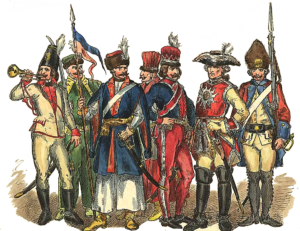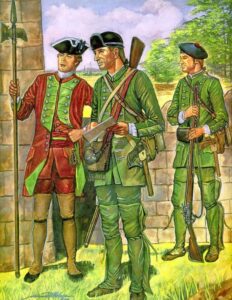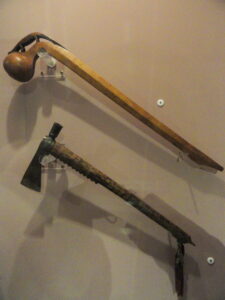As martial artists and lovers of history, we frequently share something very special to the Historical European Martial Arts community – the potential to always be one primary source away from a significantly deep rabbit hole of information.
It’s the HEMA equivalent of the “SQUIRREL!” effect.
For me, over the last few months, my squirrel has been the tomahawk. So, I wanted to share some of what I’ve come across and learned, and a little bit of that journey, as I continue to organize the information I’m gathering.
Full disclosure – and this is a great example of what I mentioned above – the tomahawk rabbit hole wasn’t even a tomahawk rabbit hole when it started.
The backstory: I wanted a new HEMA jacket. I’ve been eying the SPES Officers’ Jacket as a lighter alternative to my Neyman, and thought the dark green option was just keen. While I was looking at it, it occurred to me that (mostly as a product of my American education and Anglo-French centric history lessons) I was unaware of 17th-19th century “Officer’s” or other military jackets in that color.

See, here’s one fella wearing green – and look at his mustache! He’s dashing. This is an artists’ rendition of Polish uniforms from the early-mid 18th century, courtesy of Wiki Commons.

Some cursory research revealed they were certainly around, if not as common as the reds and blues of the wars I’d been taught about over and over again in school and university, but they popped up in Austrian, Prussian, Italian, and Russian uniforms, as well as occasionally in the Danish uniforms of the 1700s as well.
Then I stumbled across a group of soldiers who I found particularly fascinating – those of you with a military background might have to bear with me through this bit of the journey, because I swear I hadn’t ever heard of the Rogers’ Rangers until this weird research trip.
Trained by Major Robert Rogers, the Rogers’ Rangers, a British military unit in the American colonies, were primarily given the role of light infantry with an emphasis on reconnaissance. Now, again, not having a military background this is only conjecture – but I have to imagine the folks tasked with reconnaissance being the first ones to figure out “if our uniforms are green they can’t see us as well when we sneak around” adds up pretty nicely.


Irregular uniforms for the time, to be certain, but practical. Also, notice something else irregular about their kit? Tomahawks!
I started reading further and saw that almost all of the artistic depictions of them show them with tomahawks in their sword baldrics, which is quite surprising.
The Rogers’ Rangers were known to have adopted many of the practices of the local indigenous people while they traveled in regards to navigation, camping practices, and more. The “28 Rules of Ranging” for the original Rogers’ Rangers of the 1750s are the basis for U.S. Army Rangers standing orders today – this is where the U.S.’s “rangers” actually get their namesake (indirectly), and Lt. Col. William Darby read the rules to the 1st Ranger Battalion before they saw action in World War 2.
So, the tomahawks. Right.
Specifically in the “28 Rules of Ranging”, there are several references to the usage of tomahawks, which means they were being carried by the unit frequently enough to include them in the instructions of dealing with a charge.
Rogers instructs in Rule 13 that: “In general, when pushed upon by the enemy, reserve your fire till they approach very near, which will then put them into the greatest surprise and consternation, and give you an opportunity of rushing upon them with your hatchets and cutlasses to the better advantage.”
This is an extremely important part of the whole picture, and gives us some really important information.
A.) Rogers didn’t expect them to have bayonets fixed, if they had bayonets at all, even when being pushed upon.
B.) Hatchets and cutlasses are about the same length, at least, if not intentioned or designed the same way. “Sword” or “Saber” isn’t seen in the text specifically, which I think is important, and we certainly would class the cutlass and the hatchet as closer together in utilization than the cavalry saber and hatchet, I think.
C.) The hatchet/tomahawk was explicitly described in a partially combat-dedicated and non-utilitarian context for the British military in 1750.

Ball-headed war club (top), Great Lakes, from Boston Museum Collection, and Tomahawk pipe (bottom), southwestern Chippewa, collected 1889. Exhibit from the Native American Collection, Peabody Museum, Harvard University, Cambridge, Massachusetts, USA.

Once this context appeared, it started to make more sense. Reconnaissance units needed to travel fast, light, and often quietly.
Have you ever worn a sword on your hip? It is quite literally the opposite of ALL of those things. Even a very light sword like a smallsword becomes cumbersome if you intend to do anything other than stand still – let alone bushwhacking through the dense forests of the North American frontier.
So why replace the sword altogether? Again, see above. A significant deciding factor wasn’t necessarily carrying the tomahawk, it was NOT carrying the sword on these missions. Matt Easton likes to talk frequently about how what you did with a sword (or other type of weapon) 99% of the time was wear it or carry it around, and so many compromises were made in regard to the carry, comfort, and utility of the weapon’s everyday existence on your belt/back/baldric/hands/rack.
I agree with this wholeheartedly, and many modern theories around concealed carry mirror this thought – a gun that’s uncomfortable to carry is a gun you’re more likely to leave at home, and a gun you leave at home does you no good no matter how optimized or perfect it is. I’ll take a comfortably concealed weapon I can carry, over the “perfect gun for self-defense” that I just can’t find a good spot for, any day of the week.
Obviously, Rogers saw the benefits for the hatchet or tomahawk as extremely high in that 99% of the time it would be carried or worn, when compared against the longer, more nimble, combat-purpose-built sword. It’s important to note (and maybe a bit obvious), aside from being a backup weapon for melee encounters, the tomahawk (or an axe of SOME sort) was a tool that they would likely need to carry at least in small numbers even IF they had a sword. Fortifying encampments, chopping wood, hammering stakes – all tasks made easier by a hatchet, and work not easily substituted by a sword (excluding potential examples like the French “cabbage chopper” or maybe the mid-1800s Naval cutlasses that were heavy enough to be used in a tool-like fashion, but were arguably still not optimized for it).
Also, carrying one thing, instead of carrying TWO things, is arguably important when considering the haul of rations, powder, ammunition, and more a long-range reconnaissance team would be responsible for carrying without pack animals, as they attempted to stay undetected and off of major paths.
With this knowledge, and a pair of synthetic trainer tomahawks, we set out to recreate some of what MIGHT have been done with one of these tomahawks in an encounter, and to contextualize the potential fighting styles of both THESE particular Europeans and their hatchets, as well as gain some insight to the tomahawk and hatchet utilizing cultures that we don’t have even this small bit of context for, such as the indigenous American peoples and even earlier European civilizations for which hand axes survive but no record of their method of use does.
Part 2 coming soon, including what I learned in experimentation, some interesting and unique things about the tomahawk, why I would never ACTIVELY choose one over a sword for a one-on-one fight, and more.
